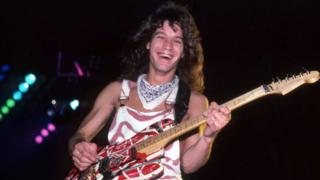How Eddie Van Halen ‘scared the hell out of a million guitarists’
Eddie Van Halen #EddieVanHalen

 Image copyright Getty Images Image caption Many of Van Halen’s biggest songs were played on Eddie’s home-made “Frankenstrat” guitar
Image copyright Getty Images Image caption Many of Van Halen’s biggest songs were played on Eddie’s home-made “Frankenstrat” guitar
Eddie Van Halen, who has died at the age of 65, opened up dozens of new possibilities for the electric guitar with his wildly inventive, and largely self-taught, techniques.
Combining lightning-quick two-handed picking techniques with hammer-ons, pull-offs, complex harmonics and an array of innovative devices he patented, the guitarist became a pole star for generations of musicians.
“Ed’s a once- or twice-in-a-century kind of guy,” his friend Jerry Cantrell of Alice in Chains said earlier this year. “There’s Hendrix, and there’s Eddie Van Halen. Those two guys tilted the world on its axis.”
Fellow guitar legend Joe Satriani reflected in 2015: “Eddie put the smile back in rock guitar at a time when it was all getting a bit broody. He also scared the hell out of a million guitarists because he was so damn good.”
The son of a Dutch band leader, Van Halen was originally a pianist, playing at weddings and bar mitzvahs with his family after they emigrated to Pasadena, California, in 1962.
A prodigious talent, he beat 5,000 students to first prize in a local piano recital for four years in a row, despite being unable to read a note of music.
“I fooled my teacher for six years,” he told Rolling Stone magazine in 1995. “He never knew. I’d watch his fingers, and I’d play it.”
In his teens, he switched to drums, then guitar, and formed his first band with his brother Alex in 1964. The Broken Combs made their debut one lunchtime in Pasadena Elementary School, and cemented the siblings’ desire to become professional musicians.
Eddie started out by imitating UK rock trio Cream, learning Eric Clapton’s solos by note by note.
But it was watching Led Zeppelin at the Los Angeles Forum in the early 1970s that changed his guitar playing forever. A lightbulb went off as Jimmy Page played the solo from Heartbreaker, using both hands to tap out notes on the neck of the guitar.
For Page, it was an opportunity to showboat – but Eddie took the technique and refined it, enabling him to play a seemingly impossible flurry of notes and pinched harmonics.
“It’s like having a sixth finger on your left hand,” he explained in 1978. “Instead of picking, you’re hitting a note on the fretboard.”
The approach was so revolutionary that Alex encouraged his brother to play gigs with his back to the audience so other bands wouldn’t steal it before Van Halen had a record deal.
Once their self-titled debut album was released in 1978, however, Eddie’s fellow guitarists were dazzled.
“It was beyond mind blowing,” said Ozzy Osbourne’s guitarist Zakk Wyld. “I’m going, ‘That can’t be a guitar. What is that?”
LA punk musician Phast Phreddie Patterson wrote in a 1978 edition of Waxpaper: “Edward wails his guitar like his life depended on it. Boyishly grinning… like a kid with a new toy, he tries to get as many noises out of his instrument as electronically possible. The results are unbelievable.”
Eddie never claimed to have invented the “two-handed tap” technique – classical guitarists had been using their picking hands to play notes their fretting hand would normally cover for years – but he did popularise it for the rock audience.
“And on top of that, I never really heard anyone do with it what I did,” he said in a 2017 interview. “Which was actual pieces of music.”
That, really, is the key. Eddie always prioritised melody and feeling over flamboyant technique. And while Van Halen’s material leaned towards hard rock, they always employed catchy hooks and memorable riffs.
Some of his best work was his most economical. On the chorus of Jamie’s Cryin’, he replies to David Lee Roth’s vocal (“Oh-oh-oh, Jamie’s crying”) with a simple two-note phrase that has all the taut precision of a Motown backing vocal.